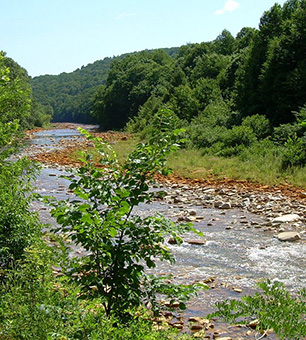Part of the Series
Gas Rush: Fracking in Depth
Researchers have found elevated levels of radioactive material and other pollutants in Pennsylvania’s scenic Blacklick Creek, and they say fracking is to blame.
Researchers at Duke University announced this week that samples collected from 2010 to 2012 near a fracking wastewater treatment facility that discharges into Blacklick Creek had up to 200 times the amount of radium than samples just upstream, as well as elevated levels of salts and heavy metals.
“The radioactivity levels we found in sediments near the outflow are above management regulations in the United States and would only be accepted at a licensed radioactive disposal facility,” said Robert B. Jackson, professor of environmental science at Duke.
Hydraulic fracturing, aka “fracking,” involves forcing high volumes of water and chemicals into underground formations to release fossil fuels. Advances in fracking technology triggered an oil and gas rush in Pennsylvania and across the country, and after several years of heavy fracking, researchers are now beginning to quantify the environmental damage.
The heavily-fracked Marcellus Shale formation under Pennsylvania is naturally high in radioactive material. In 2011, the state asked fracking firms to voluntarily stop sending wastewater to facilities like the one on Blacklick Creek until they upgraded treatment equipment, but wastewater is still discharged into the environment in some other states, according to the Duke team.
Where Do You Put Billions of Gallons of Toxic Wastewater?
The fracking industry produced 280 billion gallons of toxic wastewater in 2012 alone, according to a recent report from Environment America. Since 2005, the industry has used 250 billion gallons of fresh water to produce oil and gas, which was turned into toxic wastewater along with underground water unearthed in production.
Fracking wastewater and solid wastes such as drill cuttings (leftover broken bits of rock), can be radioactive and laced with toxic chemicals, but a loophole established over two decades ago exempts fracking wastes from federal hazardous waste rules. Rep. Matthew Cartwright (D-Pennsylvania) has introduced legislation in the House to close this loophole, but the bill has little chance of leaving committee, according to a GovTrack.us analysis.
As problems with fracking wastewater treatment drew attention to Pennsylvania, the industry became increasingly reliant on deep underground injection wells (a device that places fluid deep underground) to dispose of stored fracking wastewater, permanently taking the fresh water out of its natural cycle.
“The industry converts this water into toxic waste that is injected deep underground,” said John Rumpler, senior attorney for Environment America. “The water used for fracking is gone for good.”
Wastewater injection wells have been linked to minor earthquakes in Ohio, Oklahoma and other states.
Frackers in Pennsylvania have been sending much of their waste to injection wells and landfills in Ohio, where residents fear that their state is becoming a radioactive “dumping ground.”
Here’s some more key numbers from the Environment America report, “Fracking by the Numbers,” which quantified data submitted by the industry and state governments:
– The fracking operations produced 450,000 tons of air pollution in one year.
– Fracking has been linked to more than 1,000 instances of groundwater contamination, including 743 instances in New Mexico, where groundwater supplies drinking water for 90 percent of the state’s residents.
– The fracking industry has degraded 360,000 acres of land since 2005 by building roads, pipelines and drilling pads.
– Fracking operations emitted 100 million metric tons of global warming pollution since 2005.
Is Fracking Air Pollution Making You Sick?
Researchers are just beginning to understand the impacts of fracking air pollution on human health. Last month, environmental investigators discovered that state regulators did not issue fines against oil and gas facilities in a heavily-fracked area of Texas after they were caught illegally discharging air pollution that nearby residents believed was poisoning their families.
David Brown, a toxicologist and former public health official, has reviewed health data in Pennsylvania. Brown told reporters this week that people living near fracking facilities are being exposed to pollution and carcinogens, but it’s still too early to know what the long-term health impacts will be.
“At health clinics, we’re seeing nearby residents experiencing nausea, headaches and other symptoms linked to fracking pollution,” Brown said. “With billions of gallons of toxic waste coming each year, we’re just seeing the ‘tip of the iceberg’ in terms of health risks.”
What is most troubling, Brown said, is that the federal government is not conducting any studies to measure the impact of fracking pollution on public health.
The industry, meanwhile, continues to insist that fracking is not harming the public or the environment.
Environmentalists, however, say the numbers on fracking don’t lie.
“The bottom line is this: The numbers on fracking add up to an environmental nightmare,” said Rumpler. “For our environment and for public health, we need to put a stop to fracking.”
Rumpler suggested that states ban fracking until more information on its impacts becomes available and agencies put tougher regulations in place.
Any ban on the technology that has significantly boosted domestic oil and gas production, however, is highly unlikely.
But here’s one more number from Environment America: 1 million. That’s the number of public comments from ordinary Americans that were submitted over the summer demanding that the Obama administration reject proposed rules that would allow fracking in national forests and other public lands.
Media that fights fascism
Truthout is funded almost entirely by readers — that’s why we can speak truth to power and cut against the mainstream narrative. But independent journalists at Truthout face mounting political repression under Trump.
We rely on your support to survive McCarthyist censorship. Please make a tax-deductible one-time or monthly donation.
